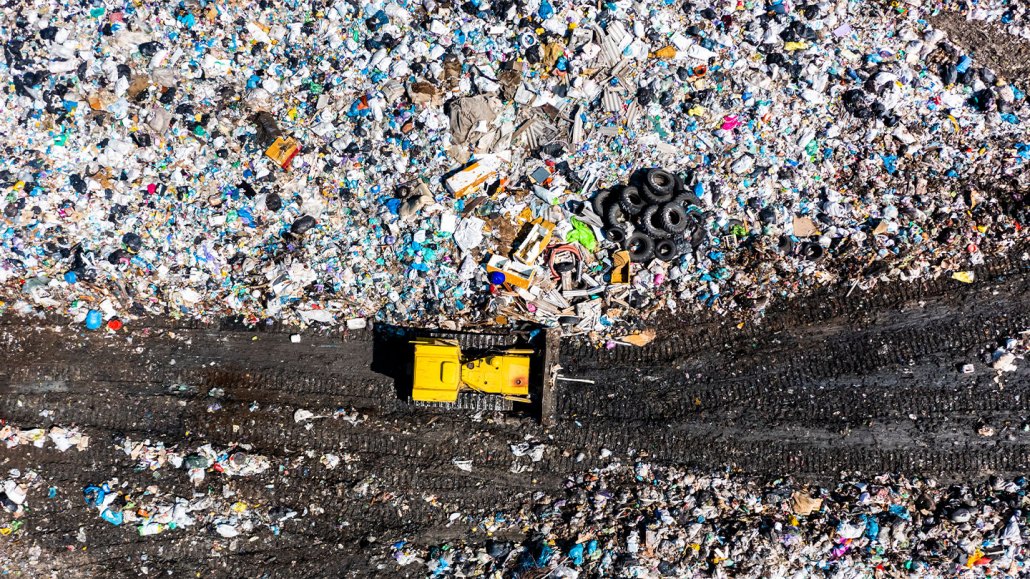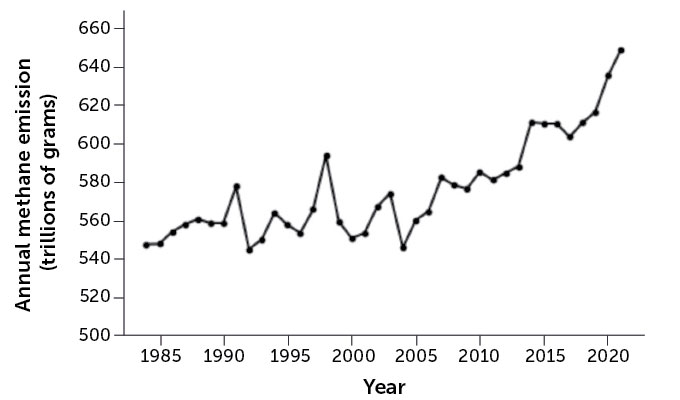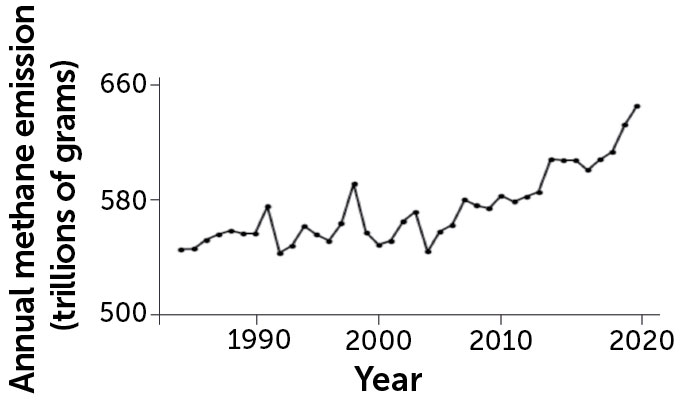
Landfills are one of the main human sources of methane to the atmosphere.
Anton Petrus/Getty Images
This year’s United Nations’ annual climate summit, dubbed COP28, is making a lot of headlines — not something I would have found myself writing a few years ago.
One reason for COP’s higher profile is a growing sense of urgency to take stronger action to reduce humans’ fossil fuel emissions and mitigate the looming climate crisis. The world is nowhere near on track to meet the goals of the 2015 Paris Agreement — that is, reducing greenhouse gas emissions sufficiently to limit global warming to “well below” 2 degrees Celsius of preindustrial averages by the year 2100 (SN: 12/12/15). Meanwhile, 2023 has been the hottest year on record, people have been suffering through a barrage of extreme weather events, including heat waves, droughts and floods, and 2024 is likely to break more temperature records (SN: 12/6/23; SN: 7/19/23).
The headlines emerging from COP28 have been a mix of pleasing, frustrating and bewildering. For example: It’s good news that 198 nations have ratified the Loss and Damage Fund, a formal acknowledgment by wealthy, high-polluting nations that they should help mitigate the rising costs of climate change faced by developing nations. But it’s frustrating that the pledges by the wealthy nations so far amount to just about $725 million, less than 0.2 percent of the annual climate change–linked losses faced by developing nations.
For me, one of the biggest questions related to those headlines pertains to methane. It feels unclear whether, on balance, there’s more good or bad news when it comes to emissions of that second most important human-caused greenhouse gas.
Methane is a powerhouse climate-warming gas, with about 80 times the atmosphere-warming potential of carbon dioxide. However, methane has a saving grace: It mercifully lingers for only about a decade in the atmosphere (SN: 4/22/20). Carbon dioxide can stick around for up to 1,000 years. Cutting methane emissions can mean its atmospheric concentration drops relatively rapidly.
The Global Methane Pledge, launched two years ago at COP26, may be gaining some momentum, but it still lacks the sign-on of key big-emitting nations. Then there’s the December 1 announcement by 49 oil and gas companies that they would reduce methane leaks from their infrastructure to “near zero” by 2030, which seems like a good thing on the face of it but has also been called greenwashing (SN: 11/24/21).
And all of this policy wrangling is happening against a bizarre backdrop: a startling, puzzling, worrisome sharp increase in methane emissions over the last decade — not from humans, but from natural sources, particularly wetlands.
To help me sift through the headlines and better understand all the news that’s seeping out, I talked with Euan Nisbet, a geochemist at Royal Holloway, University of London in Egham.
Methane “is rising very fast,” Nisbet says. “So fast it looks like the Paris Agreement is going to fail.”
Countries are promising to cut methane emissions
While the rise in natural methane emissions is worrisome, about 60 percent of current methane emissions into the atmosphere still comes from human activities. Methane doesn’t just seep out of leaky oil and gas pipelines or get pumped into the air during coal combustion. Agriculture, including ruminant animals, are a big source (SN: 5/5/22). Landfills are another (SN: 11/14/19).
That’s where the Global Methane Pledge comes in, promising a 30 percent cut in humans’ emissions by 2030. The pledge was spearheaded in 2021 by the United States and the European Union, and so far, 150 nations have signed on. Most recently, Turkmenistan, which has sizable methane emissions, joined. So there’s hope: If everyone were to follow suit, it really is possible to cut global methane emissions deeply, bringing us much closer to meeting the Paris Agreement’s goals, Nisbet argues in a Dec. 8 editorial in Science.
Still, many of the world’s biggest methane emitters, including China, India, Russia, Iran and South Africa, have not signed on to the pledge. China’s methane comes in large part from its coal combustion; India’s, from coal as well as waste heaps and biomass fires. And China alone currently releases an estimated 65 million metric tons of methane per year, more than double that of the United States or India, the next two biggest emitters.
With only seven years left before the 2030 deadline, meeting the global pledge’s methane reduction goals would be steep — but, Nisbet says, not impossible.
There’s precedent for successfully making such steep cuts to methane in such a short time, he adds. During the 2000s, “there was a seven-year period where [the U.K. government] brought methane emissions down by 30 percent,” in large part by reducing emissions from landfills and gas leaks.
China has just released its own Methane Emissions Control Action Plan in November, alongside a joint commitment between China and the United States to take action on methane. That news sounds potentially promising, if not wholly reassuring, as the plan does not include a lot of concrete numbers, Nisbet says.
So, what about the oil and gas industry’s recent promise to address its leaky infrastructure? Such a promise also sounds positive on the face of it — leaky infrastructure is definitely the low-hanging fruit when it comes to reducing humans’ methane emissions to the atmosphere (SN: 2/3/22).
On the other hand, hundreds of scientific and environmental organizations have signed an open letter in response. The letter suggests that the oil and gas industry’ promise is just greenwashing, “a smokescreen to hide the reality that we need to phase out oil, gas and coal,” the letter states. Furthermore, many oil and gas companies may routinely abandon old, still-leaking wells — effectively eliminating those leaks from their company’s emissions roster without actually stopping them.
That said, addressing the leaks does have to be done, Nisbet says. “I’d love to shut down the coal industry quickly, but I’m aware of the enormous social problems that brings. It’s a very difficult thing to nuance. You can’t go cold turkey. We’ve got to wind it down in an intelligent and collaborative way. The best thing to do is to stop the crazy leaks and venting.”
Natural methane emission has been surging
Plugging the leaks as soon as possible has taken on an increasing urgency, Nisbet says, because of a stark rise in natural methane being emitted to the atmosphere. Why this rise is happening isn’t clear, but it seems to be some sort of climate change–related feedback, perhaps linked to changes in both temperature and precipitation.
That natural methane emissions bump was also not something that the architects of the Paris Agreement saw coming. Most of that rise has happened since the agreement was signed. From 1999 to 2006, atmospheric methane had spent several years in near-equilibrium — elevated due to human activities, but relatively stable. Then, in 2007, atmospheric methane concentrations began to increase. In 2013, there was a particularly sharp rise, and then again in 2020.
Much of that increase seems to have come from tropical wetlands. Over the past decade, researchers have tracked shifts in methane sources by measuring carbon-12 and carbon-13 in the gas. The ratio of those two forms of carbon in the methane varies significantly depending on the source of the gas. Fossil fuel-derived methane tends to have higher concentrations of carbon-13 relative to carbon-12; methane from wetlands or agriculture tends to be more enriched in carbon-12.
The recent spikes in natural methane are eerily reminiscent of ice core records of “glacial termination” events, times in Earth’s deep past when the world abruptly shifted from a glacial period to a period of rapid warming, Nisbet and others reported in June in Global Biogeochemical Cycles. Such glacial termination events are large-scale reorganizations of the ocean-atmosphere system, involving dramatic changes to the circulation of the global ocean, as well as to large climate patterns like the Indian Ocean Dipole (SN: 1/9/20).
“Is this comparable to the start of a termination event? It looks horribly like that,” Nisbet says. But “it may not be. It might be totally innocent.”
Right now, scientists are racing to understand what’s happening with the natural methane bump, and how exactly the increased emissions might be linked to climate change. But as we search for those answers, there is something that humans can and must do in the meantime, he says: Cut human emissions of the gas as much as possible, as fast as possible. “It’s very simple. When you’re in a hole, stop digging.”










